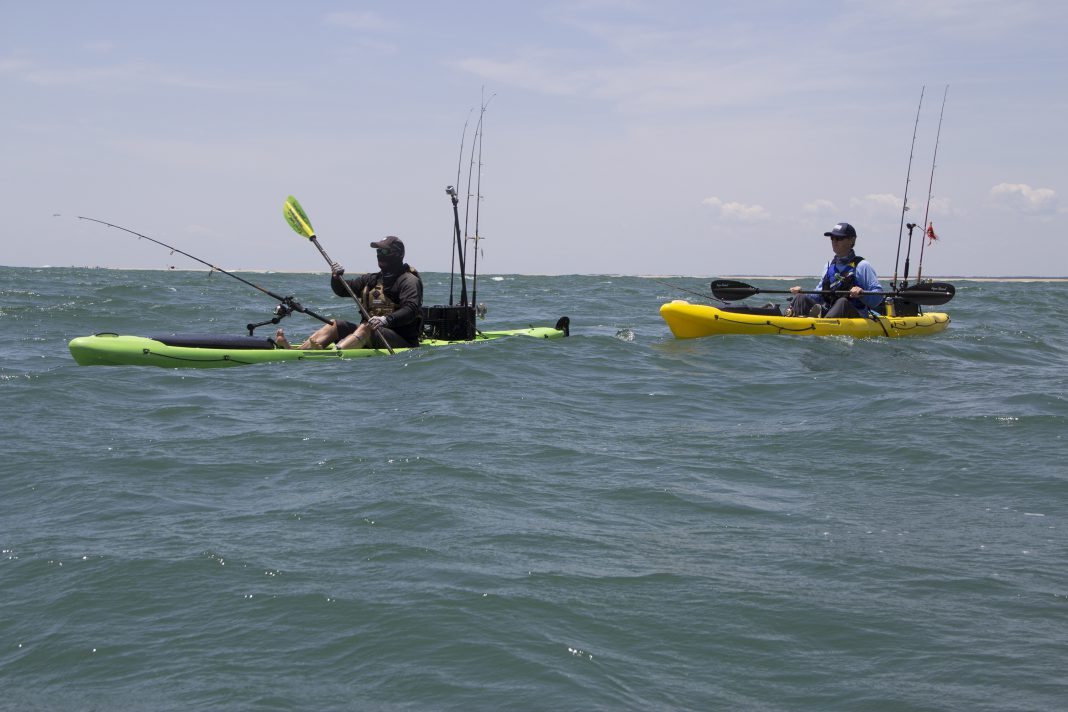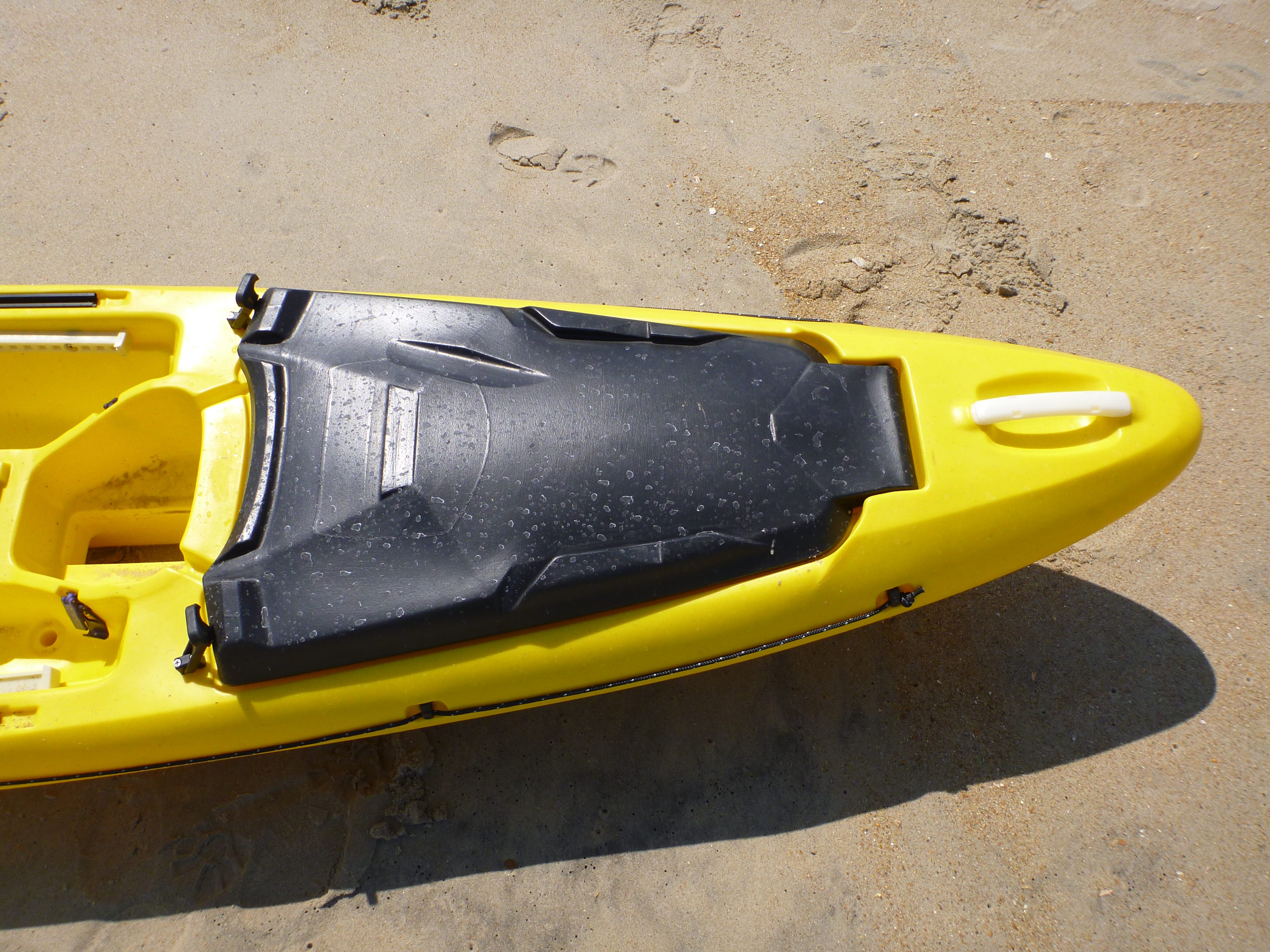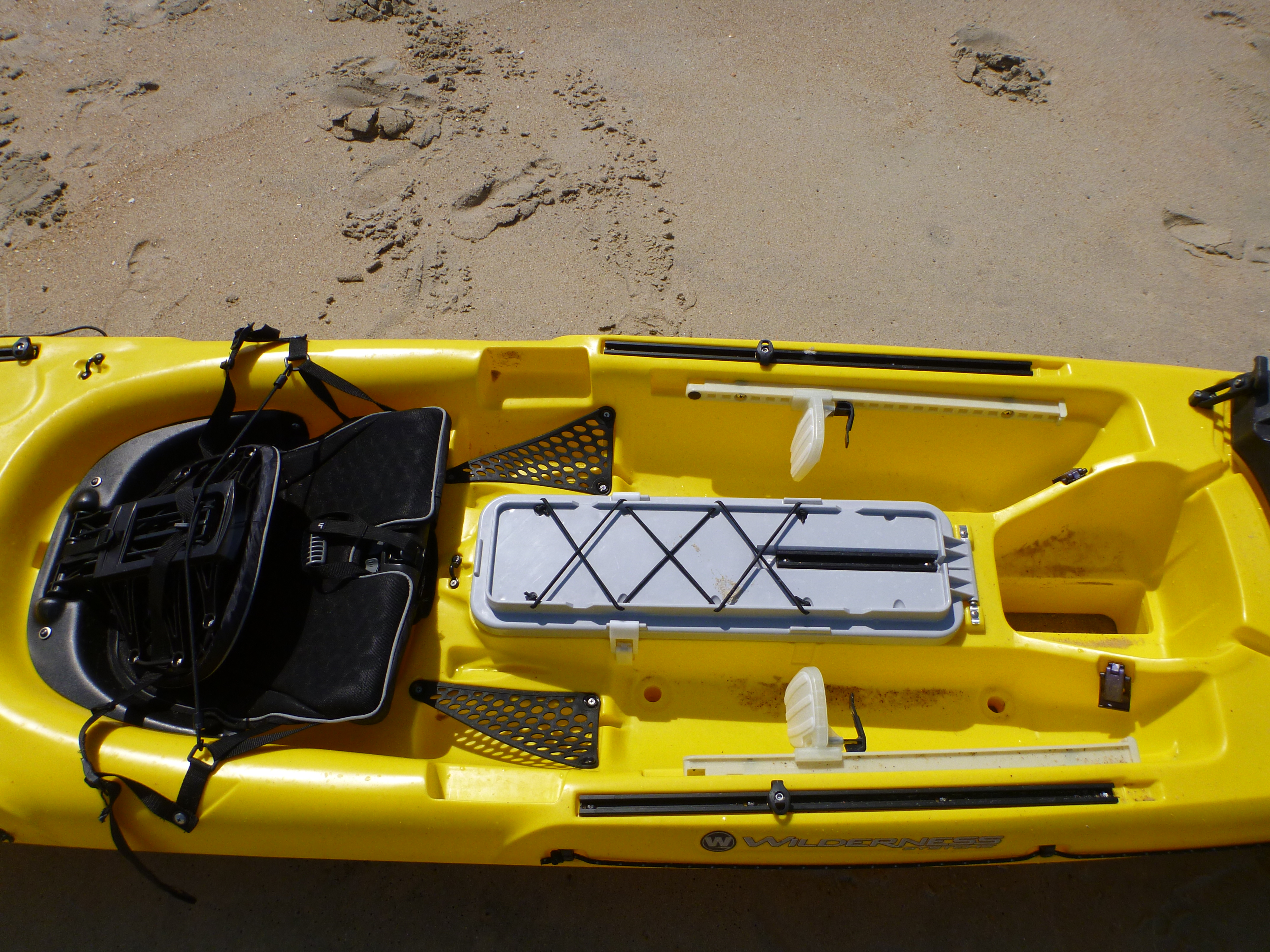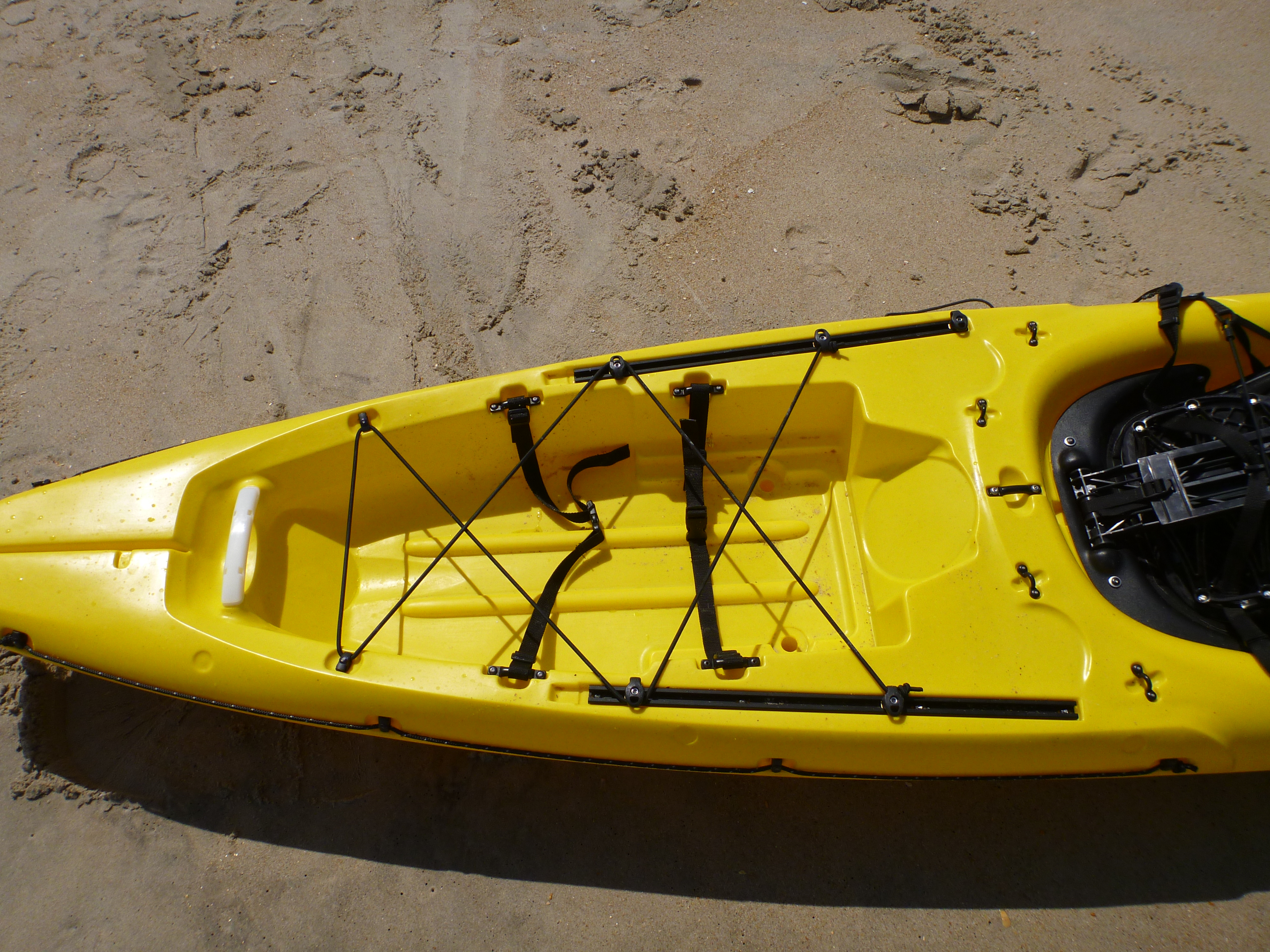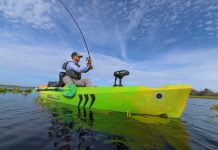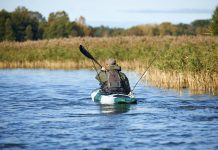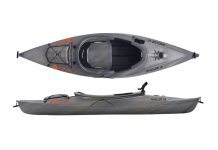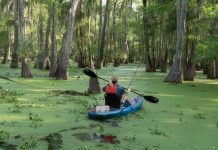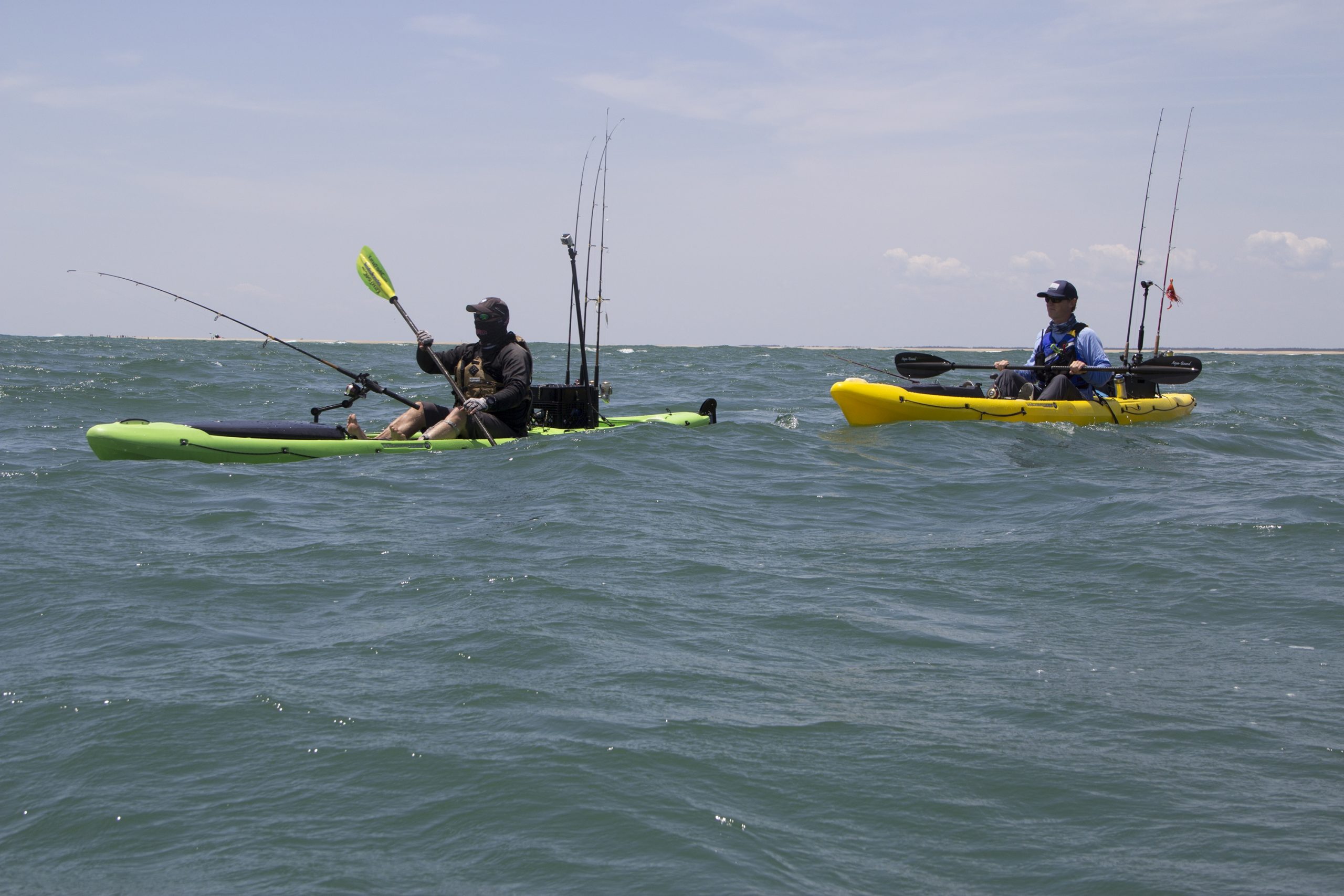
Automakers test their cars at Bonneville Salt Flats, one of the flattest, hottest, driest places on earth. Kayak makers test their kayaks at Diamond Shoals, one of the meanest, nastiest, most-feared places on the ocean. Last week I got the call from Wilderness System’s Pro Rob Alderman, a local guide and host of Fishmilitia.com. He told me that Wilderness Systems was bringing the new Thresher for a test paddle on the shoals. Fishing reports from the area had included cobia, big red drum, chopper blues, Spanish macks and false albacore, so I was in.
I drove down from Virginia Beach and met Evan Lyendecker, marketing manager and Dave Maughan product designer from Wilderness Systems. We piled into Rob’s pick-up and headed onto the beach. As Rob drove over the dunes, I watched perfect A-frame waves breaking across the bar. Wishing I had brought my surf board, not an untested kayak, I counted set waves and tried to time the lull. Luckily, Rob found a break in the bar less than a mile from the shoals, and he parked the truck so we could unload the boats.
Once I had the Thresher 140 and 155 on the sand, I could check out their fishing amenities. Wilderness has included a two-piece molded handle to the bow and another in the stern that are handy when you need them and out-of-the way of fishing lines and other snags. A huge well in the bow with a big trunk-style hatch offers easy access while on the water. Another, rectangular hatch in the cockpit can accommodate rods up over seven-feet long. The boat uses Wildy’s Phase 3® AirPro SOT seat that has proven comfortable and supportive, with a space for tackle under the seat. There are flat surfaces in front of the cockpit and behind the seat to install flushmount rod holders and the tank well is molded to accommodate a crate or live well. I threw my BlackPak into the well and used the bungees and straps to secure it for a surf launch.
I loaded three heavy spinning rods into the center hatch and chucked my raingear into the bow well then dragged the 140 through the shore break and paddled into the slough. Paddling the 155, Rob led through the cut and we paddled into open water. That’s the first I got a good look at the shoals.
Huge swells were coming from every direction and exploding on the bar. On the north side, dark green 60 degree water pushed against emerald green 70 degree water rushing in at two knots. The shoals were a perfect place to test the Thresher and my sanity.
We were lucky, the wind was blowing 20 knots out of the southwest. While this made paddling difficult, the wind was blowing with the current, which knocked down the breakers and allowed us to paddle through the deeper sloughs. Rob led the way and I followed.
The boat’s rockered hull and responsive primary stability allowed it to bounce around in the chaotic waves. The high-volume bow bounced over the chop and the secondary stability kept the boat upright. For a 14-foot kayak that is loaded with features, the boat performed well. However, the heavy wind and current maxed out the speed and maneuverability.
Despite the conditions, I was able to make head way and search the surface for cobia. These long, brown fish can grow over 100 pounds and they like to swim on the surface looking for a meal. This makes them a perfect challenge for sight casters paddling around the ocean looking for these beasts swimming in the sunshine. And there is no better place to catch them than on the Diamond Shoals. Rob had success a few days earlier and several charter boats were patrolling the outside of the shoals. Hopes were high, even if the conditions were bad.
While we worked our way around the tip of Cape Point, Rob cast a spoon and caught a feisty bluefish and then a speedy Spanish mackerel. I continued to scan the surface of the water for a brown bomber. The conditions were too rough to allow me to stand up in the boat, but the low gunnels and seat cut the wind well. Even in the un-fishable conditions, I was confident and comfortable paddling slowly ahead and looking for a chocolate clown.
Just as we rounded the shoals and pushed closest to the breaking waves, I spotted a brown shape surfing down a roller straight towards me. The 30 pound fish was only 25 yards away and coming in fast, I grabbed my heavy spinner and pitched a three ounce bucktail a few feet in front of its face. The lure landed perfectly, the fish turned, I dropped the bucktail and jigged it twice. Nothing. I jigged again. Nothing. The wind was spinning the kayak around and I was drifting fast for the breakers. I jigged again and retrieved the lure. As soon as I saw the bucktail come up through the green water, I saw the stupid cobia following close behind. I stopped cranking but the fish kept swimming, passing right under the kayak and disappearing into the green on the other side. I dropped the bucktail and jigged it off the bottom, but no bites. By now I was being whipped into the abyss and I had to admit defeat. Stupid fish.
After two hours of slow paddling and searching, we made it to the hook inside Cape Point. While we were out of the breakers and most of the current, the wind was stirring up chatter chop and white caps. I tooled around looking for another fish, but I never got a shot. With the conditions deteriorating, we pulled the plug and let the current and wind ferry us back through the shoals.
Once I was on the cold side of the break and out of the current, I found the Thresher a steady paddle with a good balance of speed and stability. The bow rides over waves but does push up spray in a headwind. The hull is responsive enough to absorb rough seas while steady enough to paddle with confidence. A slightly rockered hull and concave keel improve handling, and the boat will be even easier to maneuver with an add-on rudder system. Sacrificing handling to improve capacity and tracking is a necessary trade off with a boat designed to cover distance in rough conditions while loaded with gear. Wilderness did a good job balancing handling and utility; squeezing as much performance out of a boat packed with features.
Before paddling through the break in the bar, I stored my rods in the center hatch and strapped down my crate. Luckily, we were able to avoid the surf, and the boat scooted through the shorebreak with confidence.
Wilderness Systems included the most popular fishing features and a well-balanced hull design in the new the new Thresher. Anglers looking to pack the boat with gear and head out for a weekend, or crash the surf and charge the bluewater will find the this coastal kayak a worthy tool.
For a complete review of the Thresher, including features still in the works, check out the Summer/Fall edition of Kayak Angler available in September.
A large trunk-style bow hatch holds tons of gear and is easy to access from the seat.
Air-Pro SOT seat makes for a comfortable ride with enough support for hard paddling. A long center hatch will hold four heavy spinning rods. The new foot pegs are easy to adjust and stay-up. Track systems and deck loops are liberally applied to the top-side of the hull.
A large tankwell in the stern criss-crossed with bungees and straps will keep gear and live well in place.

